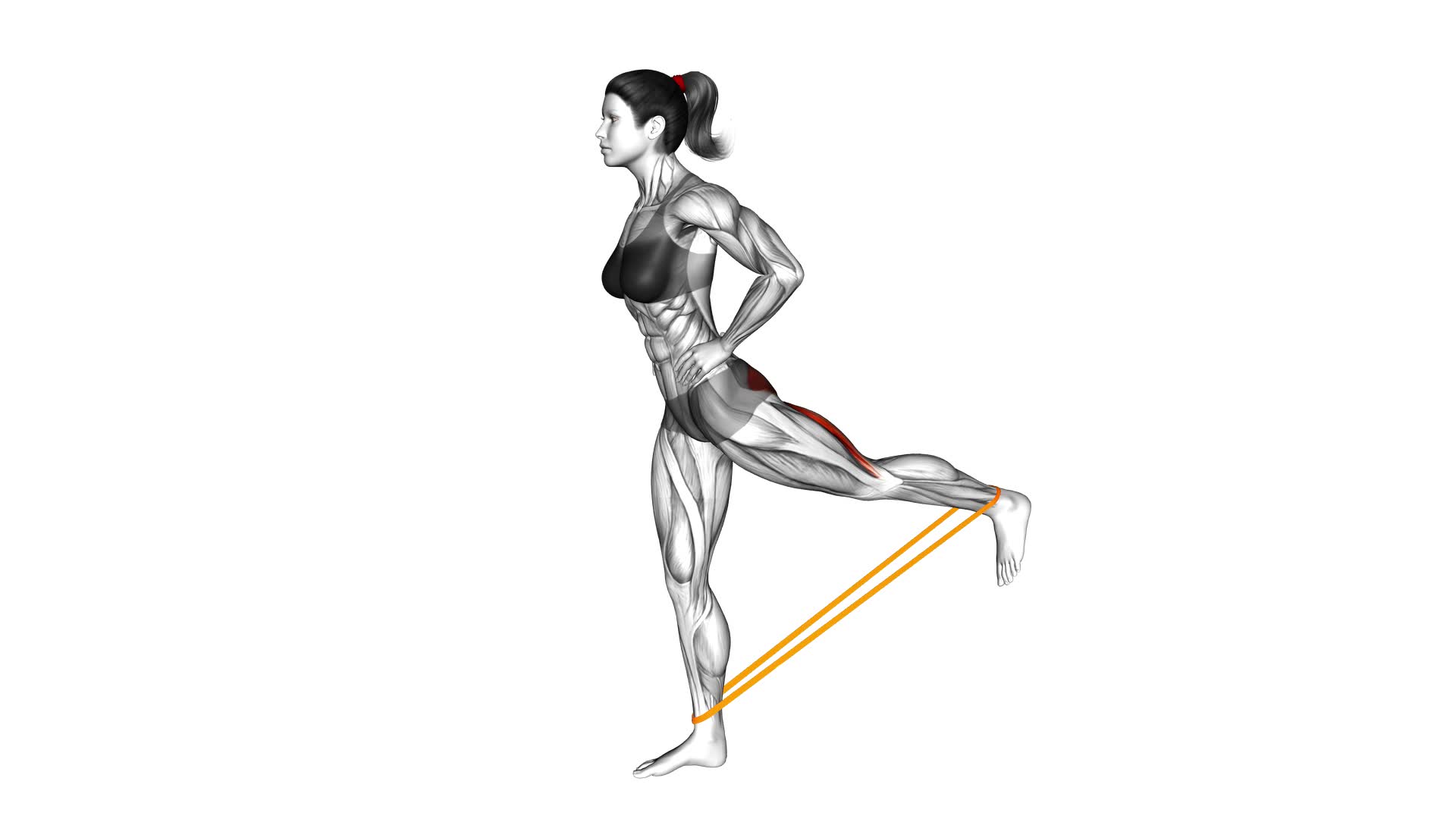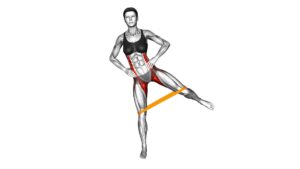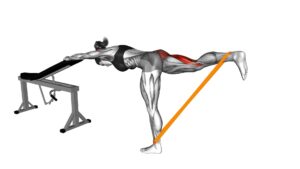Resistance Band Standing Balance Glute Kickback (female) – Video Exercise Guide & Tips

Are you looking to tone your glutes and improve your balance? Look no further than the resistance band standing balance glute kickback!
Watch This Exercise Video
This exercise is perfect for women of all fitness levels, and with the help of our video exercise guide and tips, you'll be on your way to sculpted, strong glutes in no time.
Follow along and learn the proper form and technique, variations for different fitness levels, and tips for maximizing your results.
Get ready to kick those glutes into shape!
Key Takeaways
- Builds glute strength
- Improves balance and stability
- Enhances hip mobility
- Engages core muscles
Benefits of Resistance Band Glute Kickbacks
Discover the advantages of incorporating resistance band glute kickbacks into your workout routine. Resistance band glute kickbacks are an effective exercise for glute activation and muscle targeting. By using a resistance band, you can enhance the intensity and challenge of the exercise, leading to greater muscle activation and growth.
One of the main benefits of resistance band glute kickbacks is their ability to specifically target the glute muscles. As you kick your leg back against the resistance of the band, you engage the gluteus maximus, medius, and minimus. These muscles are responsible for hip extension, abduction, and external rotation, respectively. By targeting these muscles, you can develop stronger and more defined glutes.
In addition to muscle targeting, resistance band glute kickbacks also provide an effective form of glute activation. This means that they help to wake up and activate the glute muscles before engaging in other lower body exercises. By activating the glutes, you can improve your overall performance and reduce the risk of injuries during your workout.
Incorporating resistance band glute kickbacks into your workout routine can bring about numerous benefits. They effectively target the glute muscles and help to activate them, leading to stronger and more defined glutes. So, grab a resistance band and start incorporating glute kickbacks into your workouts for optimal results.
Proper Form and Technique
To perform the resistance band glute kickback exercise with proper form and technique, you'll need a resistance band and should follow these guidelines.
First, secure the resistance band around your ankles and stand with your feet hip-width apart. Engage your core muscles and maintain a neutral spine throughout the exercise.
Next, shift your weight onto one leg while keeping a slight bend in the knee. This will help with stability and balance. As you exhale, extend the opposite leg backward while maintaining a straight line from your head to your heel. Avoid arching your back or rotating your hips during the movement.
To maximize results, focus on squeezing your glute muscles at the top of the movement and control the lowering phase.
Common mistakes to avoid include using momentum to lift the leg and not fully extending it, as well as allowing the resistance band to pull your leg inward or outward.
By performing the resistance band glute kickback exercise with proper form and technique, you can effectively target and strengthen your glute muscles.
Now, let's explore variations for all fitness levels.
Variations for All Fitness Levels
For individuals of all fitness levels, there are several variations of the resistance band standing balance glute kickback exercise that can be incorporated into their workouts. Whether you're a beginner or more advanced, these modifications allow you to tailor the exercise to your specific needs and abilities.
For beginners, it's important to start with simpler modifications that focus on building strength and stability. One option is to perform the exercise without a resistance band initially, focusing on mastering the movement and maintaining balance. Another modification is to use a lighter resistance band or loop the band around the ankles instead of above the knees. This reduces the intensity of the exercise while still targeting the glute muscles effectively.
For those who are more advanced, there are several ways to increase the difficulty of the resistance band standing balance glute kickback exercise. One option is to use a heavier resistance band or increase the tension by looping the band around the thighs. This adds more resistance, making the exercise more challenging and engaging the glutes even more. Another modification is to perform the exercise on an unstable surface, such as a Bosu ball or balance board. This further challenges your balance and stability, forcing the glute muscles to work harder.
Tips for Maximizing Results
To maximize your results with the resistance band standing balance glute kickback exercise, focus on maintaining proper form and gradually increasing the intensity. By doing so, you can enhance your performance and achieve the desired outcomes more effectively.
First and foremost, it's crucial to ensure that you have the correct form throughout the exercise. Stand tall with your feet hip-width apart and engage your core muscles. Keep your back straight and shoulders relaxed. As you lift your leg, make sure to extend it fully, squeezing your glutes at the top of the movement. Avoid swinging your leg or arching your back, as this can detract from the effectiveness of the exercise.
Furthermore, gradually increasing the intensity of the exercise will help you maximize your results. Start with a lighter resistance band and gradually work your way up to a heavier one as your strength improves. You can also increase the number of repetitions or sets to challenge your muscles further.
It is essential to listen to your body and not push yourself too hard, especially if you're a beginner. Allow yourself enough time to rest and recover between workouts to prevent injury and promote muscle growth.
Safety Precautions and Common Mistakes to Avoid
To ensure your safety and avoid common mistakes, it's important to follow these guidelines when performing the resistance band standing balance glute kickback exercise.
First and foremost, it's crucial to warm up properly before starting any exercise routine. This will help prepare your muscles for the workout and reduce the risk of injuries.
When performing the resistance band standing balance glute kickback exercise, it's important to maintain stability throughout the movement. Make sure to engage your core muscles to keep your body aligned and balanced. This won't only prevent injuries but also maximize the effectiveness of the exercise.
Another common mistake to avoid is using too much resistance. Start with a lighter band and gradually increase the resistance as you become more comfortable and confident with the exercise. This will prevent strain on your muscles and reduce the risk of injury.
Additionally, it's important to perform the exercise in a controlled manner. Avoid swinging your leg or using momentum to lift it. Focus on squeezing your glutes and using your muscles to lift your leg behind you. This will ensure that you're targeting the right muscles and minimizing the risk of injury.
Frequently Asked Questions
How Many Reps and Sets Should I Do for Resistance Band Standing Balance Glute Kickbacks?
For optimal results, it's recommended to perform 3 sets of 12-15 reps for resistance band standing balance glute kickbacks. This exercise targets your glute muscles and helps improve balance.
Remember to use a weight that challenges you without compromising your form.
Additionally, allow yourself adequate rest and recovery periods between sets to prevent overexertion and promote muscle growth. Rest is just as important as the exercise itself for achieving your fitness goals.
Can Resistance Band Standing Balance Glute Kickbacks Help With Cellulite Reduction?
Resistance band standing balance glute kickbacks can be a beneficial exercise for cellulite reduction. By targeting the glute muscles, these kickbacks help to tone and strengthen the area, potentially reducing the appearance of cellulite.
However, it's important to note that no exercise can specifically target cellulite, as it's caused by factors like genetics and skin structure.
In addition to kickbacks, incorporating other glute activation exercises like squats and lunges can further enhance your results.
Will Resistance Band Standing Balance Glute Kickbacks Make My Thighs Bigger?
Resistance band standing balance glute kickbacks primarily target your glutes, not your thighs. These exercises focus on glute activation and building lean muscle mass in that area.
While they may indirectly engage your thighs, they won't necessarily make them bigger. Instead, they can help sculpt and tone your glutes, improving overall lower body strength and stability.
Incorporating these exercises into your routine can contribute to a more balanced and toned physique.
Can Resistance Band Standing Balance Glute Kickbacks Be Done Without a Resistance Band?
Yes, you can do alternative exercises for standing balance glute kickbacks without a resistance band. However, using a resistance band offers unique benefits.
It adds resistance to your workout, making it more challenging and effective for targeting your glute muscles.
The band also helps with stability and balance, which is important for this exercise.
Are Resistance Band Standing Balance Glute Kickbacks Safe for Individuals With Knee Injuries?
Should individuals with knee injuries avoid resistance band standing balance glute kickbacks?
It's important to consider the safety and potential risks associated with this exercise. Knee injuries can be sensitive, and certain movements may exacerbate the condition.
It's recommended that individuals with knee injuries consult with a medical professional or physical therapist before attempting resistance band standing balance glute kickbacks. They can provide personalized guidance and suggest alternative exercises that are safe and effective for rehabilitation.
Conclusion
In conclusion, resistance band standing balance glute kickbacks are an effective exercise for targeting and strengthening the glute muscles. By maintaining proper form and technique, individuals of all fitness levels can benefit from this exercise.
To maximize results, it's important to vary the resistance level and incorporate variations of the exercise. However, it's crucial to prioritize safety and avoid common mistakes to prevent injury.
Incorporating resistance band glute kickbacks into your workout routine can help you achieve stronger and more defined glutes.

Author
Years ago, the spark of my life’s passion ignited in my mind the moment I stepped into the local gym for the first time. The inaugural bead of perspiration, the initial endeavor, the very first surge of endorphins, and a sense of pride that washed over me post-workout marked the beginning of my deep-seated interest in strength sports, fitness, and sports nutrition. This very curiosity blossomed rapidly into a profound fascination, propelling me to earn a Master’s degree in Physical Education from the Academy of Physical Education in Krakow, followed by a Sports Manager diploma from the Jagiellonian University. My journey of growth led me to gain more specialized qualifications, such as being a certified personal trainer with a focus on sports dietetics, a lifeguard, and an instructor for wellness and corrective gymnastics. Theoretical knowledge paired seamlessly with practical experience, reinforcing my belief that the transformation of individuals under my guidance was also a reflection of my personal growth. This belief holds true even today. Each day, I strive to push the boundaries and explore new realms. These realms gently elevate me to greater heights. The unique combination of passion for my field and the continuous quest for growth fuels my drive to break new ground.







